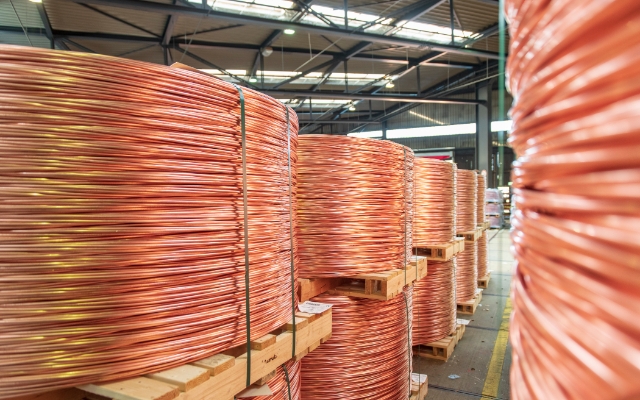Exploring the Diverse Applications of Copper Products in Modern Industries
From enhancing the effectiveness of electric systems to playing an important role in sustainable power technologies, the convenience of copper is noticeable. As industries progressively focus on innovation and sustainability, the varied applications of copper warrant a closer evaluation, especially concerning their prospective influence on future environmental methods and technical innovations.
Electrical Applications of Copper
Copper is an essential material in the electrical industry, accounting for about 60% of the total need for non-ferrous steels globally - Copper Products. Its exceptional electrical conductivity, which is nearly twice that of aluminum, makes it the preferred choice for a variety of electric applications. From wiring systems in industrial and domestic structures to high-voltage power transmission lines, copper makes sure effectiveness and reliability in electricity shipment
Along with wiring, copper is integral to the production of electrical parts such as motors, generators, and transformers. These components utilize copper's thermal conductivity and pliability, crucial for warmth dissipation and efficient performance. Copper's resistance to corrosion boosts the life expectancy and toughness of electrical systems, making it a cost-efficient option in the long term.
The development of eco-friendly energy sources, such as solar and wind power, has additionally raised the need for copper in electric applications. As industries transition towards sustainable power options, copper's duty comes to be also more crucial. Overall, the flexibility and performance qualities of copper strengthen its condition as a keystone product within the electric market, driving technology and effectiveness across various applications.
Plumbing and Piping Solutions
In contemporary pipes systems, the selection of products dramatically influences both functionality and durability. Copper has become a preferred choice because of its distinct buildings, consisting of rust resistance and antimicrobial attributes. These characteristics guarantee that copper piping remains risk-free and resilient for delivering safe and clean water, an important consideration in domestic and industrial applications.
One of the vital advantages of copper in pipes is its capability to stand up to heats and stress, making it suitable for a range of applications, from warm water systems to home heating and cooling down networks. Additionally, copper's adaptability permits easier installment in intricate piping formats, reducing the risk of failures and leaks.
One more noteworthy benefit is copper's long life expectancy, frequently surpassing 50 years with proper upkeep. This durability not only lessens replacement costs but also contributes to sustainable practices by minimizing waste. Additionally, copper's recyclability straightens with contemporary ecological requirements, advertising a circular economy within the pipes market.
Copper in Renewable Power
The flexibility of copper extends beyond pipes applications, playing a vital role in the renewable energy sector. In solar panels, copper is made use of in photovoltaic or pv cells and electrical wiring, assisting in efficient energy conversion and transmission.

Additionally, as the international need for electric automobiles (EVs) rises, copper's role in battery systems and charging framework becomes also more considerable. The product's capability to carry out electrical power effectively is important to the performance of EV batteries, improving variety and billing speed.
Copper's Function in Electronics
Electronics manufacturing counts greatly on copper's remarkable residential properties, specifically its high electric conductivity and thermal efficiency. These qualities make copper an optimal option for a large range of digital components, consisting of adapters, circuit card, and electrical wiring. The steel's capability to efficiently send electric signals makes sure very little energy loss, which is critical in high-performance digital gadgets.
Moreover, copper's thermal conductivity plays a significant duty in heat dissipation, protecting delicate elements from overheating. This is especially vital in contemporary electronic devices, where small layouts cause enhanced warm generation. Copper is additionally favored for its pliability and ductility, enabling it to be easily formed into complex designs that fulfill the demands of innovative electronic applications.
With the surge of consumer electronic devices, telecommunications, and electrical vehicles, the demand for copper in the electronics market remains to grow. As innovations in innovation progress, copper remains important to achieving higher efficiency and reliability in digital items. Its recyclability even more boosts its appeal, as makers look for lasting solutions without endangering high quality. Therefore, copper remains a keystone product in the ever-expanding area of electronic devices.
Innovative Utilizes in Manufacturing

One significant application is in additive manufacturing, where copper-based products are employed in 3D printing processes. This permits for the development of light-weight components and complicated geometries, particularly in the aerospace and automobile industries. Furthermore, copper's thermal conductivity makes it an excellent choice for warm exchangers, improving effectiveness in industrial air conditioning systems.
Furthermore, the increase of clever manufacturing has seen the incorporation of copper in IoT tools, where its conductive capabilities support advanced picking up technologies. In the realm of renewable resource, copper is essential in the manufacturing of photovoltaic panels and wind turbines, helping with more reliable power conversion and circulation.
As sectors strive for sustainability and innovation, copper's convenience and efficiency proceed to place it as an essential product, driving innovations in production and adding to the development of smarter, more efficient products.
Conclusion
The integral function of copper in renewable power and its important feature in electronics highlight its value in advancing lasting practices. Jointly, these applications illustrate copper's crucial contribution to technical progress and commercial efficiency in modern society.
From enhancing the efficiency of electrical systems to playing a crucial function in eco-friendly energy innovations, the adaptability of copper is evident. As markets significantly prioritize advancement and sustainability, the varied applications of copper require a closer assessment, especially concerning their potential effect on future technological advancements and environmental methods.
The growth of sustainable power sources, such as solar and wind power, has try this web-site better boosted the demand for copper in electrical applications. Generally, the versatility and performance characteristics of copper strengthen its standing as a keystone product over at this website within the electrical industry, driving advancement and performance across various applications.
The flexibility of copper prolongs beyond plumbing applications, playing an important function in the eco-friendly energy industry.